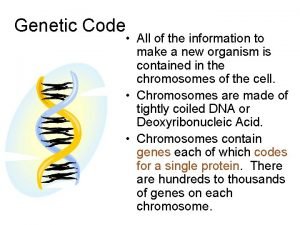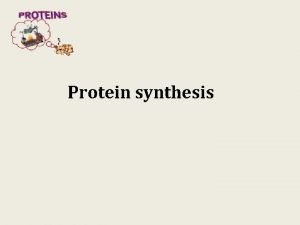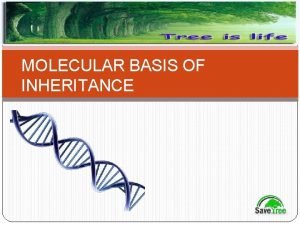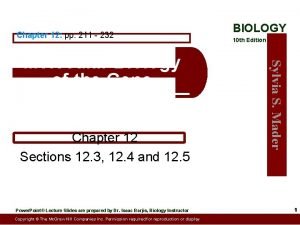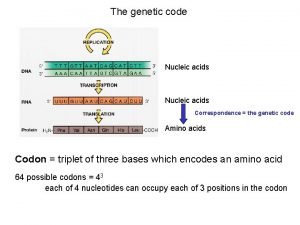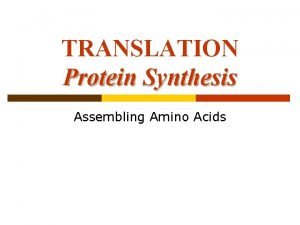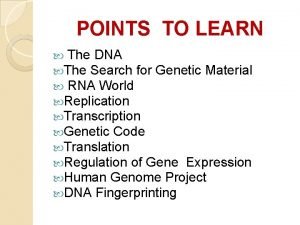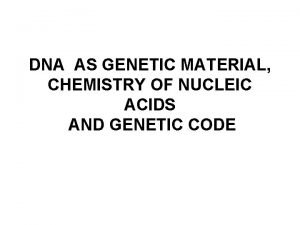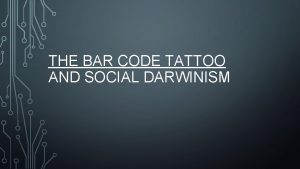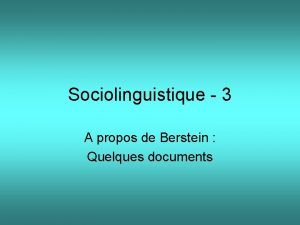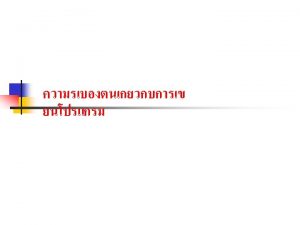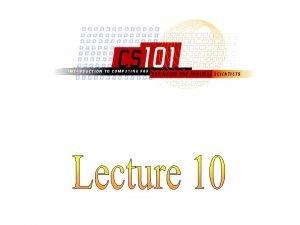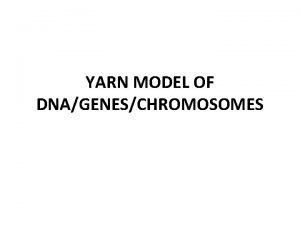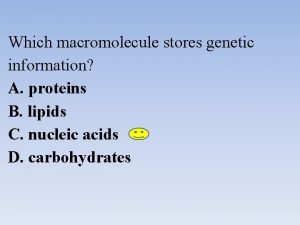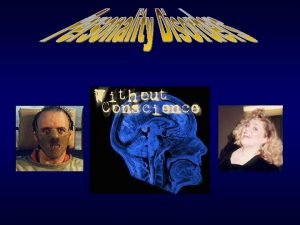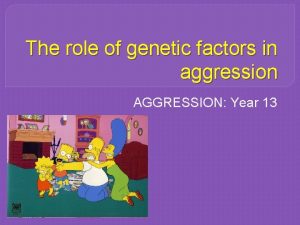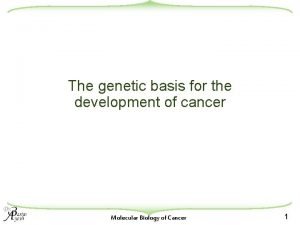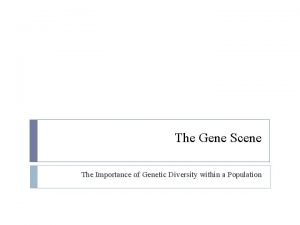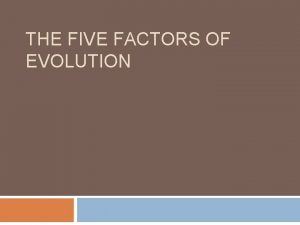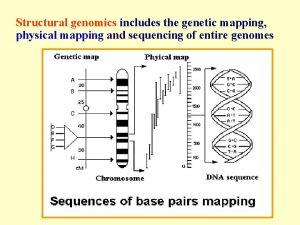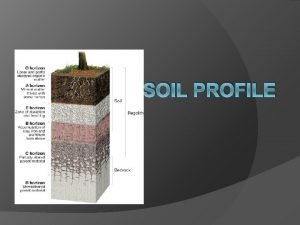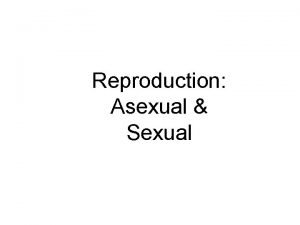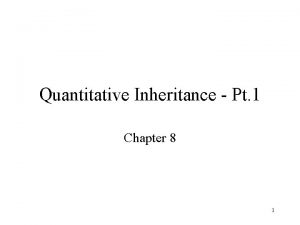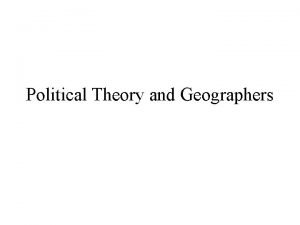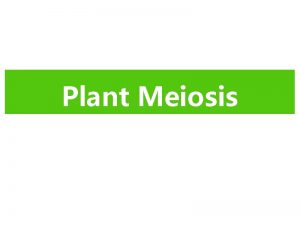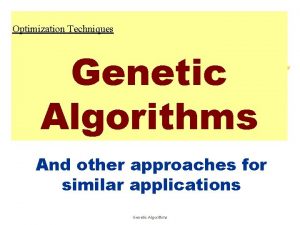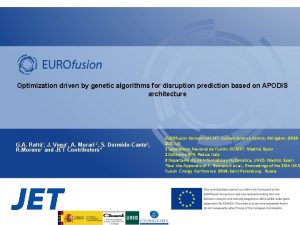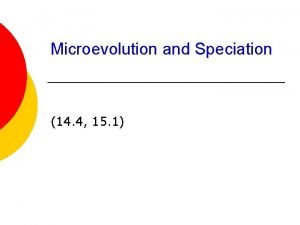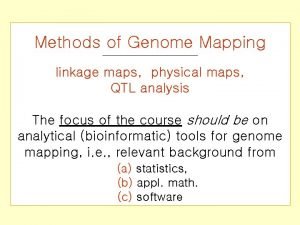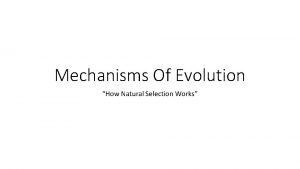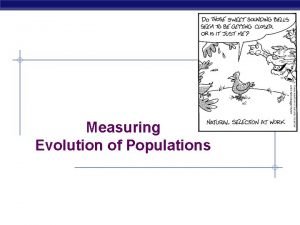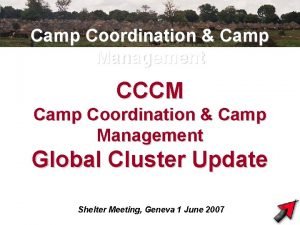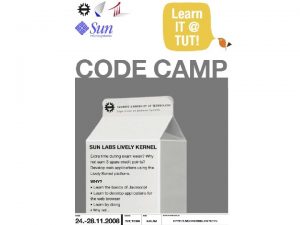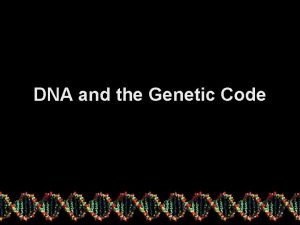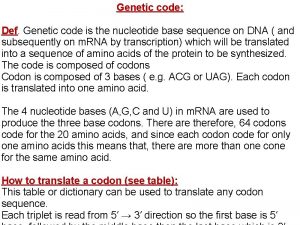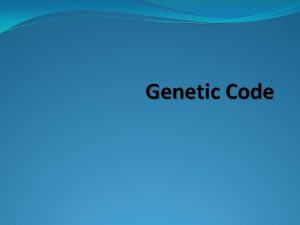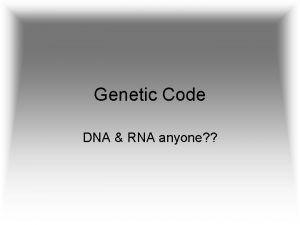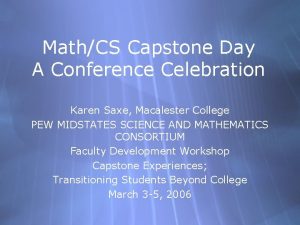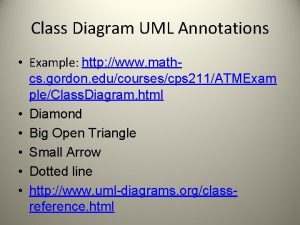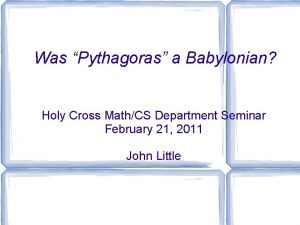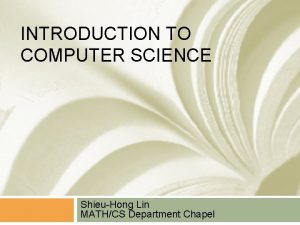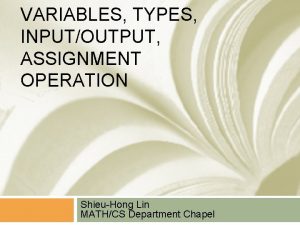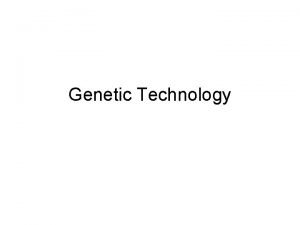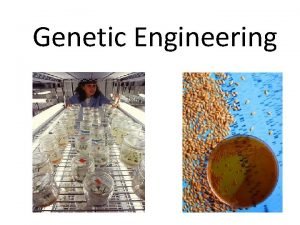The Genetic Code MathCS Camp 19 07 06

























































































- Slides: 89

The Genetic Code Math-CS Camp, 19. 07. 06, Singapore Mikhail S. Gelfand Research and Training Center of Bioinformatics, Institute for Information Transmission Problems, Moscow, Russia and Department of Bioengineering and Bioinformatics, Moscow State University

The Biological Code by Martynas Yčas (London, 1969) Биологический код (Mосква, 1971) 1956 1951 -55 1946 -50 1941 -45 193 X 192 X 191 X 190 X 18 XX

To apply mathematics in biology, a mathematician has to understand biology. Israel Gelfand

Plan • Pre-history – Genetics – Evolutionary theory – Chemistry • Cracking the Code • Update

Genetics: Gregor Mendel (1822 -1884) • Attended the Philosophical Institute in Olomouc • Since 1843 – at the Augustinian Abbey of St. Thomas in Brno • 1851 -1853 – studied in the University of Vienna • 1856 -1863 – cultivated 28 thousand pea plants • The Three Laws of Genetics (“Experiments on Plant Hybridization”) – Read to the Natural History Society of Brunn in Bohemia (1865) – Published in Proceedings of the Natural History Society (1866) • Since 1866 – abbot, stopped working in science

The seven traits of pea plants studied by Mendel

The first law Crossing two pure lines different in some trait (e. g. yellow / green seeds), one gets only one variant (allele) in the first generation (the dominant allele) F 0 F 1

The second law Crossing two pure lines different in some trait (e. g. yellow / green seeds), one gets only one variant (allele) in the first generation (the dominant allele), and the distribution 3: 1 of the dominant and recessive alleles in the second generation. F 0 F 1 F 2

(Law of large numbers) The 3: 1 ratio is seen only when the number of observations is sufficiently high. F 0 F 1 F 2

The third law Two different traits are inherited independently (in the second generation the ratio is 9: 3: 3: 1) F 0 F 1 F 2

F 2

What if we take a pair with a different assortment of the same traits? F 0 F 1 F 2 F 0 ?

Same F 1 F 2 F 0 F 1

Same F 2 … regardless of the initial assortment F 2 F 0 F 1

Incomplete dominance

Incomplete dominance ?

Incomplete dominance ?

Incomplete dominance

Charles Darwin (1809 -1882) • 1825 -27 in Edinburgh University and 182731 in University of Cambridge – natural history, geology, botany • 1831 -1836 – Voyage of the Beagle • Journal of Researches into the Geology and Natural History of the various countries visited by H. M. S. Beagle (1839)

Origin of Species (1859)

The Law of Natural Selection • Species make more offspring than can grow to adulthood. • Populations remain roughly the same size. • Food resources are limited, but are relatively constant most of the time. • In such an environment there will be a struggle for survival among individuals. • In sexually reproducing species, generally no two individuals are identical. • Much of the variation is heritable. • Individuals with the "best" characteristics will be more likely to survive … • … those desirable traits will be passed to their offspring … • … and then inherited by following generations, becoming prevalent and then fixed among the population through time.

Thomas Huxley (1825 -1895) “Darwin’s Bulldog”

Origin of Homo sapiens

Re-discovery of the Mendel laws and emergence of modern genetics • Hugo de Vries (1900) • William Bateson – genetics, gene, allele • Walter Sutton – Link between genes and chromosomes(1902) • Archibald Garrod – Genetic cause of some human disease (1902 -08 -23) • Thomas Morgan, work on Drosophila. – Mutants: spontaneous appearance of new alleles (a fly with white eyes in a population of flies with red eyes) (1908) – Universal acceptance of chromosomes (1915)

Gene = a set of non-complementing mutations Edward Lewis: Do two recessive mutations occur in the same gene? F 1: Mutant phenotype F 1: Wild-type phenotype

Mutant phenotypes persist in cis (same gene). Mutant phenotypes reappear in trans (different genes) F 2 F 1: Mutant phenotype F 2: All mutant phenotypes F 1: Wild-type phenotype F 2 WT WT Mut Mut Mut 1 2 4 2 1 9: 7

DNA • Friedrich Miescher (1869) – Nucleolin – Richard Altmann: nucleic acid (1889). Only in chromosomes • Phoebus Levene (1929) – Components (four bases, the sugar-phosphate chain) – Nucleotide: phosophate+sugar+base unit • Hammarsten and Casperson (1930 s) – DNA is a long polymer; crystals • Astbury (1938) – X-ray photographs • Chargaff rules (1947) – In many organisms, #A=#T, #C=#G

Transforming factor (Frederick Griffith, 1928)

… = DNA (Oswald Avery, Colin Mc. Leod, Maclyn Mac. Carthy, 1944)

DNA is the genetic medium of phages (Alfred Hershey and Martha Chase, 1948) 32 P – radioactive DNA 35 S – radioactive proteins Only DNA enters the cell

… and only DNA is inherited by progeny phages

Erwin Schrödinger “What is life”, 1946: The gene is an aperiodic crystal

The structure of DNA … • Maurice Wilkins and Rosalind Franklin: high-resolution crystals (1950 -1953)

… is the double helix James Watson and Francis Crick (1953)

The Nature paper: a few lines more than one page

The DNA chain

Complementary pairs of nucleotides С Т G A

Figures from the second Watson-Crick paper

The main distances are the same

One base-pair in the double helix (axial view)

The double helix, stick and ball models, axial view

The double helix, stick and ball models, side view

Three models for the replication of DNA

The semi-conservative one is correct (Matthew Meselson and Franklin Stahl, 1958) Cells are grown on the 15 N (heavy) medium for several generations, then transferred to 14 N (light) medium Q: What would be the outcome if one of the two other models were correct?

Electron micrograph of replicating DNA

The Central Dogma (F. Crick) DNA RNA protein

Crossingover and recombination • Genes from one chromosome are not inherited independently • Recombination allows for relative mapping of gene positions on the chromosome: if two genes are close, the frequency of recombination will be lower

Collinearity of the gene and the protein (Charles Yanofsky, 1967)

The Genetic Code • The genetic code: correspondence between DNA and protein (George Gamow, 1954) (Георгий Гамов) • Crick and co-authors (1961): – – Non-overlapping (one mutation affects one amino acid) Degenerate (many codons for one amino acid) Comma-less (no specific markers between codons) Periodic

The codon is a triplet • Mutations caused by acridine – Non-leaky (instead of weakened function, simply no function) – Mechanism: insertions and deletions of nucleotides (the downstream part of the gene completely scrambled the code is comma-less) CUACUACUACUACUACUACUA Leu. Leu G insertion CUACUACUACGUACUACUACUACUACU Leu. Arg. Thr U deletion CUACUACUACUACUACACUACUACUAC Leu. His. Tyr

Double mutants and revertants • Two classes of mutations: (+) and (–) • Double mutants (+)¤(+) and (–)¤(–) still produce loss-offunction phenotypes • Double mutants (+)¤(–) and (–)¤(+) produce leaky phenotypes CUACUACUACGUACUACUACUACUACU Leu. Arg. Thr ¤ CUACUACUACUACUACACUACUACUAC Leu. His. Tyr CUACUACUACGUACUACUACACUACUACUA Leu. Arg. Thr. Leu




Triple mutants are revertants! • Triple mutants of the same class, (+)¤(+) and (–)¤(–), produce leaky phenotypes CUACUACUACGUACUACUACUACUACU Leu. Arg. Thr ¤ CUACUACUACGUACUACUACUACU Leu. Arg. Thr double mutant – loss of function phenotype CUACAUCUACGUACUACUACUACUAC Leu. Arg. Thr. Tyr ¤ CUACUACUACUACUACGUACUACU Leu. Arg. Thr triple mutant – leaky phenotype CUACUACUACGUACUACUACGUACUACUACUA Leu. Arg. Thr. Tyr. Val. Leu


Cracking the Code (F. Crick, M. Nirenberg, J. Matthaei, S. Ochoa, G. Khorana, … and you) • Regular oligonucleotides – … UUUUU … – … UCUCUC … – … UCAUCAUCAU … • Random oligonucleotides with known composition • Changes in proteins caused by deaminationcaused mutations: C U, A G • Changes in proteins caused random mutations • (t. RNA binding in the presense of trinucleotides)

20 amino acids and 64 codons • • • • • Alanine Cysteine Aspartate Glutamate Phenylalanine Glycine Histidine Isoleucine Lysine Leucine Methionine Asparagine Proline Glutamine Arginine Serine Threonine Valine Tryptophan Tyrosine UUU UUC UUA UUG CUU CUC CUA CUG AUU AUC AUA AUG GUU GUC GUA GUG Phe UCU UCC UCA UCG CCU CCC CCA CCG ACU ACC ACG ACA GCU GCC GCA GCG Pro UAU UAC UAA UAG CAU CAC CAA CAG AAU AAC AAA AAG GAU GAC GAA GAG Lys UGU UGC UGA UGG CGU CGC CGA CGG AGU AGC AGA AGG GGU GGC GGA GGG

Triplet binding data (from Crick’s Croonian lecture, 1966)

Reading the code: The ribosome

Translation

Polysomes

Adaptors (F. Crick and S. Brenner)

t. RNA: secondary structure

t. RNA: three-dimensional structure

t. RNA and aminoacid-t. RNA-synthetase

Initiation of translation

Translation start sites dna. N gyr. A ser. S bof. A csf. B xpa. C met. S gca. D spo. VC fts. H pab. B rpl. J tuf. A rps. J rpo. A rpl. M ACATTATCCGTTAGGAGGATAAAAATG GTGATACTTCAGGGAGGTTTTTTAATG TCAATAAAAAAAGGAGTGTTTCGCATG CAAGCGAAGGAGATGAGAAGATTCATG GCTAACTGTACGGAGGTGGAGAAGATG ATAGACACAGGAGTCGATTATCTCATG ACATTCTGATTAGGAGGTTTCAAGATG AAAAGGGATATTGGAGGCCAATAAATG TATGTGACTAAGGGAGGATTCGCCATG GCTTACTGTGGGAGGAGGTAAGGAATG AAAGAAAATAGAGGAATGATACAAATG CAAGAATCTACAGGAGGTGTAACCATG AAAGCTCTTAAGGAGGATTTTAGAATG TGTAGGCGAAAAGGAGGGAAAATAATG CGTTTTGAAGGAGGGTTTTAAGTAATG AGATCATTTAGGAGGGGAAATTCAATG

Translation start sites aligned dna. N gyr. A ser. S bof. A csf. B xpa. C met. S gca. D spo. VC fts. H pab. B rpl. J tuf. A rps. J rpo. A rpl. M ACATTATCCGTTAGGAGGATAAAAATG GTGATACTTCAGGGAGGTTTTTTAATG TCAATAAAAAAAGGAGTGTTTCGCATG CAAGCGAAGGAGATGAGAAGATTCATG GCTAACTGTACGGAGGTGGAGAAGATG ATAGACACAGGAGTCGATTATCTCATG ACATTCTGATTAGGAGGTTTCAAGATG AAAAGGGATATTGGAGGCCAATAAATG TATGTGACTAAGGGAGGATTCGCCATG GCTTACTGTGGGAGGAGGTAAGGAATG AAAGAAAATAGAGGAATGATACAAATG CAAGAATCTACAGGAGGTGTAACCATG AAAGCTCTTAAGGAGGATTTTAGAATG TGTAGGCGAAAAGGAGGGAAAATAATG CGTTTTGAAGGAGGGTTTTAAGTAATG AGATCATTTAGGAGGGGAAATTCAATG

Elongation

Termination of translation

Dialects • • • The genetic code is not universal … but the differences are relatively minor … occur mainly in small genomes of organelles … and involve specific codon families. In many cases symmetry is increased, or entire families reassigned. • Many changes involve stop codons

Reassignment CUN (=CUU, CUC, CUA, CUG): Leu Thr Possible initiation codons in addition to AUG (Met): NUG (=GUG, UUG, CUG), AUN (=AUU, AUC, AUA) UAA, UAG: stop Gln

More symmetry AUU AUC AUA AUG Ile Ile Met AGU AGC AGA AGG Ser Arg Ser UGU UGC UGA UGG Cys stop Trp

Vulnerable codon families CGU CGC CGA CGG Arg Arg none AGU AGC AGA AGG Ser Arg GGU GGC GGA GGG Gly Gly Ser Gly stop none

Stop-containing families UGU UGC UGA UGG Cys stop Trp UAU UAC UAA UAG Tyr stop Cys Sec Gln (Pyl)

How many letters are there in the English alphabet?

How many letters are there in the English alphabet? • 26 (everybody knows) …

How many letters are there in the English alphabet? • 26 (everybody knows) … • … but we are discussing the book by Yčas …

How many letters are there in the English alphabet? • 26 (everybody knows) … • … but we are discussing the book by Yčas … • … so everybody are naïve

How many amino acids? • Chemists: hundreds – many occur in proteins: post-translation modifications • How many amino acids are encoded by DNA?

Crick:

Is formyl-methionine a “standard” amino acid? • Occurs in bacteria at N-termini of all recently synthesized proteins (may be enzymatically removed later on) • Has three codons: AUG, GUG, UUG – unlike “inernal” methionine encoded only by AUG – by the way, internal GUG encodes Valine and internal UUG encodes Leucine

Selenocysteine • In all three domains of life (bacteria, eukaryotes, archaea) • Encoded by UGA followed by a special hairpin structure (SECIS) – without this hairpin UGA is a stop-codon – several genes for selenoproteins per genome (or none) – corresponds to cysteine in homologs (more efficient in enzymes) • Complicated mechanism of incorporation (specific t. RNA, seryl-t. RNA-synthetase, conversion to Se. Cys on t. RNA, specific elongation factor)

Alignment of SECIS elements

The consensus SECIS structure

SECIS elements: examples

Pyrrolysine • In methanogenic archaea • A derivative of lysine • Directly encoded (unlike selenocysteine). Standard mechanism: – UAG codon – specific t. RNA – aminoacyl-t. RNA • UAG rarely used as a stop codon – never as the only stop of a gene

Thanks • Wikipedia • Ergito • Authors of papers, photographs and Internet resources • • Professor Leong Hon Wai The organizers The assistants The students
 Order of bases in dna
Order of bases in dna Founder's effect
Founder's effect Genetic programming vs genetic algorithm
Genetic programming vs genetic algorithm Genetic programming vs genetic algorithm
Genetic programming vs genetic algorithm Genetic drift vs genetic flow
Genetic drift vs genetic flow What is the difference between genetic drift and gene flow
What is the difference between genetic drift and gene flow Https://teach.classdojo.com
Https://teach.classdojo.com Busceral
Busceral Write the characteristics of genetic code
Write the characteristics of genetic code General features of genetic code
General features of genetic code Properties of genetic code
Properties of genetic code Genetic code
Genetic code Genetic code wheel
Genetic code wheel Mrna
Mrna Salient features of genetic code
Salient features of genetic code Genetic code properties
Genetic code properties Genetic code tattoo
Genetic code tattoo Boston code camp
Boston code camp Hát kết hợp bộ gõ cơ thể
Hát kết hợp bộ gõ cơ thể Bổ thể
Bổ thể Tỉ lệ cơ thể trẻ em
Tỉ lệ cơ thể trẻ em Voi kéo gỗ như thế nào
Voi kéo gỗ như thế nào Tư thế worm breton
Tư thế worm breton Hát lên người ơi alleluia
Hát lên người ơi alleluia Các môn thể thao bắt đầu bằng tiếng nhảy
Các môn thể thao bắt đầu bằng tiếng nhảy Thế nào là hệ số cao nhất
Thế nào là hệ số cao nhất Các châu lục và đại dương trên thế giới
Các châu lục và đại dương trên thế giới Công thức tiính động năng
Công thức tiính động năng Trời xanh đây là của chúng ta thể thơ
Trời xanh đây là của chúng ta thể thơ Mật thư anh em như thể tay chân
Mật thư anh em như thể tay chân Làm thế nào để 102-1=99
Làm thế nào để 102-1=99 độ dài liên kết
độ dài liên kết Các châu lục và đại dương trên thế giới
Các châu lục và đại dương trên thế giới Thơ thất ngôn tứ tuyệt đường luật
Thơ thất ngôn tứ tuyệt đường luật Quá trình desamine hóa có thể tạo ra
Quá trình desamine hóa có thể tạo ra Một số thể thơ truyền thống
Một số thể thơ truyền thống Cái miệng xinh xinh thế chỉ nói điều hay thôi
Cái miệng xinh xinh thế chỉ nói điều hay thôi Vẽ hình chiếu vuông góc của vật thể sau
Vẽ hình chiếu vuông góc của vật thể sau Thế nào là sự mỏi cơ
Thế nào là sự mỏi cơ đặc điểm cơ thể của người tối cổ
đặc điểm cơ thể của người tối cổ Thứ tự các dấu thăng giáng ở hóa biểu
Thứ tự các dấu thăng giáng ở hóa biểu Vẽ hình chiếu đứng bằng cạnh của vật thể
Vẽ hình chiếu đứng bằng cạnh của vật thể Tia chieu sa te
Tia chieu sa te Thẻ vin
Thẻ vin đại từ thay thế
đại từ thay thế điện thế nghỉ
điện thế nghỉ Tư thế ngồi viết
Tư thế ngồi viết Diễn thế sinh thái là
Diễn thế sinh thái là Dot
Dot Các số nguyên tố
Các số nguyên tố Tư thế ngồi viết
Tư thế ngồi viết Lời thề hippocrates
Lời thề hippocrates Thiếu nhi thế giới liên hoan
Thiếu nhi thế giới liên hoan ưu thế lai là gì
ưu thế lai là gì Sự nuôi và dạy con của hươu
Sự nuôi và dạy con của hươu Sự nuôi và dạy con của hổ
Sự nuôi và dạy con của hổ Hệ hô hấp
Hệ hô hấp Từ ngữ thể hiện lòng nhân hậu
Từ ngữ thể hiện lòng nhân hậu Thế nào là mạng điện lắp đặt kiểu nổi
Thế nào là mạng điện lắp đặt kiểu nổi Code élaboré code restreint
Code élaboré code restreint Managed and unmanaged code
Managed and unmanaged code Code in assembly language
Code in assembly language Difference between source code and machine code
Difference between source code and machine code Code switching
Code switching Dna model using yarn
Dna model using yarn Which macromolecule stores information
Which macromolecule stores information Is psychopathy genetic
Is psychopathy genetic Genetic vocabulary worksheet answer key
Genetic vocabulary worksheet answer key Discuss the role of genetic factors in aggression
Discuss the role of genetic factors in aggression The genetic basis of cancer
The genetic basis of cancer Why is genetic diversity important
Why is genetic diversity important The five factors of evolution
The five factors of evolution Tgenetics
Tgenetics Genetic vs physical map
Genetic vs physical map O a e b c r
O a e b c r Asexual vs sexual reproduction
Asexual vs sexual reproduction Dominant genetic variance
Dominant genetic variance Dominant genetic variance
Dominant genetic variance Genetic classification of boundaries
Genetic classification of boundaries Genetic vs physical map
Genetic vs physical map Tournament selection
Tournament selection Fitness function in genetic algorithm
Fitness function in genetic algorithm Store and transmit hereditary information
Store and transmit hereditary information Chapter 12 section 1 dna the genetic material
Chapter 12 section 1 dna the genetic material Microevolution
Microevolution Genetic map vs physical map
Genetic map vs physical map Genetic recombination
Genetic recombination Mechanism of evolution
Mechanism of evolution What is gene flow and genetic drift
What is gene flow and genetic drift
